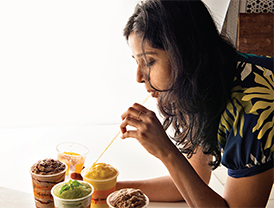 Having crossed over 20 active years in commercial photography, Dilip Yande says his forte is Fashion and Portrait photography. He believes variety is the spice of life, and to keep himself motivated he does a lot of tabletop as well. For Dilip, names like Rembrandt, Renoir, Gauguin, Picasso, Turner, Monet are household names because of his childhood that was spent in a lineage of fine arts. This ‘fine art’ reflects in his work because he feels that there is always a little bit of ‘you’ in everything one does. Having shot for many advertising agencies, juried a few competitions, mentored many workshops, and guided many photographers in their formative years, for Dilip, photography is just another way to romance his first love – art. He may be contacted at dilipyande@gmail.com
Having crossed over 20 active years in commercial photography, Dilip Yande says his forte is Fashion and Portrait photography. He believes variety is the spice of life, and to keep himself motivated he does a lot of tabletop as well. For Dilip, names like Rembrandt, Renoir, Gauguin, Picasso, Turner, Monet are household names because of his childhood that was spent in a lineage of fine arts. This ‘fine art’ reflects in his work because he feels that there is always a little bit of ‘you’ in everything one does. Having shot for many advertising agencies, juried a few competitions, mentored many workshops, and guided many photographers in their formative years, for Dilip, photography is just another way to romance his first love – art. He may be contacted at dilipyande@gmail.com
Dilip Yande
I have mentioned in my previous articles that photographing tabletops is the art of putting life in dead objects. Th is is achieved by good composition and lighting; and the use of right props makes it even more attractive.

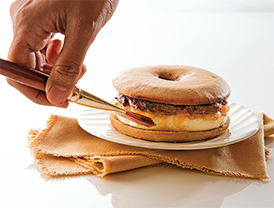
Let me go a step further and educate you with information and knowledge of a very specialized line connected to food photography – and that is food styling. Food photography has to arouse the senses of the viewer and create a feeling in the mind to taste the dish.
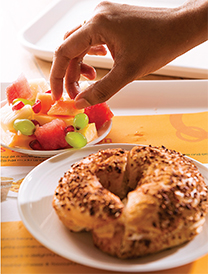
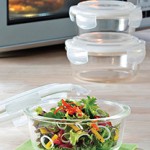
Similar to what makeup men or hairstylists do in a fashion shoot, a food stylist does the same in tabletop makeup and plays the major role in preparing and presenting the dish placed before the camera. This is a very specialized line of work and takes years of experience to learn the tricks of the trade and understand the properties of food.
Food stylists are needed by still photographers as well as the cinematographers who shoot television commercials (TVCs). In case of television commercials, the job is even more diffi cult, as sometimes the camera is moved over the food or the dish is rotated on a turn-table or steam has to be seen when photographing a pipinghot biryani or a mouth- watering splash of a blue mint slush has to be photographed in slow motion. Hence fift y percent credit for any good shot involving food photography has to be given to the food stylist!
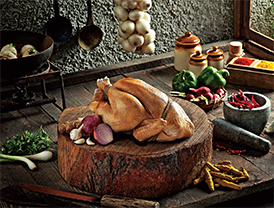

Many new and budding photographers have a lot of queries as to how to go about in case of food photography and when to involve a food stylist onto the job. I’ll try to clear all your diffi culties one by one, by fi rst introducing and posing few questions to a reputed food stylist of the industry – Arati Kamat Fedane. Later, I will explain how best to go about it.
Q – What made you take this profession as a food stylist?
Arati: I was a research chef for a leading and reputed cook book. Th e making of the recipe book involved briefi ng the photographers and having the food photographed by them. It was during this period of my career that I discovered this profession of a stylist, understood its importance, and fell in love with it.
Q – Defi ne food styling.
Arati: Creating a feast for the eyes – making food look so picturesque, that one is tempted to eat what one sees in the photo.
Q – Do you have categories in this
topic of food styling?
Arati: No. One should know the basics of cooking to be able to style it. If the stylist has rightly understood the culture of the land for whom the dish is being styled, it would help the team of stylist, the photographer and the production person to decide on the right props.
Q – In what way is food styling diff erent from being a good chef?
Arati: A chef makes food that tastes good; a food stylist makes food that looks good! A chef ’s main concern is taste and aroma; the food stylist looks at textures, shape, appearance, freshness, garnishing etc.
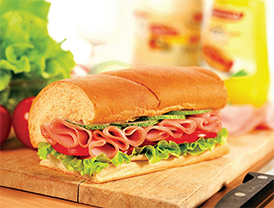
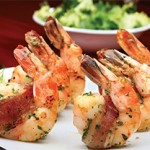
Q –
Do you feel that a food stylist is a good chef? Or, are all good chefs good food stylists?
Arati: Not sure… but it always helps if a food stylist is a good chef as only then can he/she modify the food so that it looks good. The same can be said for a chef…if he can make the food look good as well.. its always an advantage!
Q -In food styling, what is it that you enjoy doing the most? Indian food, non-Indian food (then specify), cocktails and mocktails, fast-food, tandoors, etc or ice-creams? Is there any specialization in any subtopic, looking at the international platform?
Arati: Every day is an adventure. Every day is a new challenge; that’s whats exciting about this work. Personally, I enjoy styling most of the food. Because in every category you mentioned, there is a different challenge and there is a different technique.
Q – Which do you feel is the most challenging category of the lot?
Arati: Styling ice-creams in summer, that too if the art director or client insists on an outdoor shot.
Q -Do they make dummy ice-cream scoops for the shoot? Or is it real ice-cream?
Arati: It goes both ways. Entirely
depends on the client. Both can be
made to look nice in the picture.
Q -What is the exact role of a food-stylist in terms of propping a picture with background, general props, table props, cutlery, crockery
etc.?
Arati: In smaller shoots, the food stylist organizes everything; in larger ones, there is a designated propstylist. It’s more fulfilling as an artist if I undertake to do the whole thing, as then I can visualize the whole picture and bring it to life.
Q – How many shots can be photographed in a day?
Arati: Ideally, about 6 -7.
Q – Is a well styled yummy-looking
dish necessarily palatable?
Arati: Hahaha… well…it looks yummy…that’s what we get paid for; it’s not necessary for it to be edible!
Q – Could you give photographers general tips on the ‘chemistry’ involved in food- styling?
Arati: (1) If you want show chillies floting in vinegar, put fresh chillies in water (instead of vinegar) and add salt to it.
2) Mix glycerin with water to create condensation droplets
3) Add salt to make beer more frothy
4) Add vinegar when cooking rice to make it more white
5) Sprinkle iron filings on food and then add hydrochloric acid over it to make it look piping hot.
6) Apply salt to apple slices to prevent them form turning blackish, then brush the slices when you are about to take the shot.
Q – In the olden days, coloured Pic 1 crockery was ‘in’; these days white crockery is preferred. Similarly, are there any changes in style at the international level which we follow here in terms of styling?
Arati: Old wood is now ‘in’ as a background. Also, an imperfect or casual look is preferred. Few years ago everything in a shot had to look perfect or rather ‘picture perfect’… now we purposely tend to do things like put some crumbs around the dish, drop a bit of sauce somewhere etc. It should be artistically messy! And that is where an experienced food-stylist, an experienced photographer and a seasoned artdirector score. Remember it should not look shabby!
Q – Should a photographer necessarily have a pantry or a small kitchen in his studio set-up to cater to food photography? Or can you make some make-shift arrangements?
Arati: Great if he has..its always an advantage. However, the most essential is a water tank. I can carry my gas and set up a kitchen on basic wooden tables but if there is no water, it’s a bit difficult. The above answers must have cleared a lot of doubts from the reader’s mind. Now, as a photographer, let me advise you how to execute a food photography assignment. Always follow the steps given below –
1) Understand the brief given by the client and request the advertising agency involved to send you the layouts of the pictures that are to be shot. In case of editorial features in magazines or recipe books, make it clear whether the client needs horizontal or vertical compositions.
2) If it is your first food shoot or the client’s first shoot then prove the importance of a food-stylist to him by showing a few examples from the net.
3) Understand the dishes that are to be shot, whether it is a Chinese recipe, tandoor or mocktails.
4) Clarify with your client as to who will arrange for the props and the suitable backgrounds, like for example marine wood or black glass.
5) Mail the visuals and the brief to, the food-stylist and then arrange what is known as a PPM (Pre ‘Production Meeting) with the client. It is important that the meeting comprises of not just the client, you and the food stylist, but should also involve the designer or the advertising agency involved in the job.
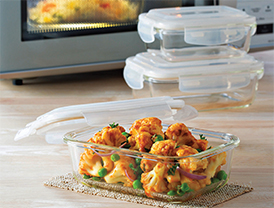
6) Keep a separate corner or room for the food-stylist to work. Amenities like a refrigerator to keep vegetables fresh are a must.
7) First place the empty dish on the table in front of the camera and decide an almost perfect composition by placing the various props and cutlery. Keep either a small blower, a napkin, a painting brush, or cotton buds handy to remove any unwanted elements or stains.
8) Perfection in lighting comes with experience. ‘Idlis’ have to be lit up in a different way while spicy ‘curry’ calls for a different lighting all together. So arrange the lights (more or less) and then ask the stylist to bring the dish. Final garnishing can take place once the dish is in place. You as a photographer should be very fast now in fine-tuning the lighting, measuring the exposure with a lightmeter and photographing before the food starts losing its freshness.
9) In case of photographing for packaging, one has to be a lot more careful as to where exactly the logo and the brand name would appear. A negative space (a blank space) has to be kept in the composition for the same. Care should to be taken in knowing the actual size of thenbox meant for the packing, keeping in mind that the dimensions/aspect ratio of your camera frame and the box are not the same.
10) The photographer should previsualize his shots. He should be clear whether he is photographing kitchen appliances, crockery or cutlery and whether the food is a part of the shot. The composition, styling and lighting has to be done accordingly. While photographing magazine ads, one has to be careful in knowing whether the client wants a vertical format for a full page ad or a horizontal format for a half page ad. The framing of the shot has to be done accordingly. Food styling involves a lot of ‘tabletop makeup’. Pictures 1, 2, and 3 are examples of the same, showing how a dish is slowly made ready for the shoot. In pic 1 the stylist is placing few drops of coloured syrup on the ice cream to make it look more ‘yummy’. In pic 2 she is carefully shaping and brushing off the extra liquid. In pic 3 it can be seen as to how a dish of mixed fresh fruits is being styled by carefully deciding the place for every slice.
Pic 4a, 4b the photographer has opted to show an entire ambiance of a kitchen platform or a corner, hence a narrower camera aperture has been used to keep other objects sufficiently sharp. In pic 5 the photographer wanted to give more importance to the ‘fillings’ in the bread roll, hence a shallow depth of field was preferred. Pic 6 also shows the clever use of shallow depth of field.
In Pic 7a & Pic 7b there is continuity in the two pics in terms of positioning the oven which the art director wanted to be positioned behind the container containing the main food item. The client preferred that the details of the oven are visible to some extent, since only part of it was to be shown.
Hence a good & experienced food stylist in any food photography shoot is a ‘must’ & with the value additions can take the standard of the whole shoot much above than what your client may expect.
Credit Lines-
Pic 1,2,3 by Anushree Bhatter
Pic 4a, 4b by Dhruv Pandya
Pic 5 by Payal Choksi
Pic 6 by- Pawan Manglani
Pic 7a & b- Courtesy- BOROSIL
Pic 5

